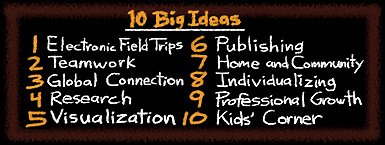
Your View
 |
||
| Choose Your View |

|
|
The Internet and the Web have immense resources that can be tapped for classroom learning and instruction. Some of the greatest resources are the museums that have been created both by institutions and by individuals. Accessing museums and other Internet and Web resources frees teachers and students from the constraints imposed by their school libraries and allows much broader access to information. Additionally, electronic field trips also help acquaint students and teachers with resources that they may use in the future.
|
|
|
Many educational researchers, teachers, and policy makers now believe that students learn through participation in social
interaction. Teamwork involves two or more people working together on a task. Collaborative learning, or cooperative learning, or group learning, involves students working as a team on some kind of learning task. The Web supports collaborative activiites across a spectrum of possibilities, from writing a paper or book together, to sharing the work on large scale science projects. The power of the Web is in its support for distributed work that can be shared through the medium of the Internet.
|
|
|
The world is getting smaller, as countries strive to work
together, and classrooms are opening up to connect with
people outside their walls. The adage, "Think Globally, Act
Locally," is now an important part of many school activities.
Global connections
is about thinking globally, communicating with others outside your local community, broadening your horizons, and building relationships with
people all over the world. Teachers have traditionally given
lessons on cultural and global issues, and now the Internet
provides a new forum for communicating with people across
the earth.
|
|
|
Research, which involves the systematic search for answers to questions, has been affected by the advent of the Internet. Older research methods and habits such as library visits and interviewing are still relevant in the context of a classroom that has access to Internet technology. However, research on the Internet introduces a host of new considerations that any conscientious researcher will have to face in conducting research of some quality. Students who gain experience in conducting research on the Internet will be better equipped to face these issues than students who have not had any exposure to the possibilities and issues associated with Internet research.
|
|
|
Models provide a powerful learning tool for students in a
variety of subjects and grade levels. Multiple representations of complex concepts and phenomona help students understand them in a deep and meaningful way. There
are models of molecules interacting, of social behavior, of the solar system, of climate changes, and of the human body. Computers and the Internet provide teaches with new models and tools for helping students visualize and understand subjects through exploration and active learning. The Web also offers numerous resources for using computer-based visualization in the K-12 classroom.
 |
|
|
Teachers are just beginning to explore the Web as a medium for
publishing their students' work. Web publication offers extensions
to traditional forms of classroom publishing such as submitting writing to journals and anthologies or making books. The Web offers teachers and students several advantages over these traditional means of publishing. Students and teachers can retain control over the format and content of the works they've created. The process of Web publication may also be quicker and less expensive than traditional publications. But most uniquely, the Web provides an
immediate and real audience that has the ability to communicate feedback
to young authors.
|
|
|
Home and Community.
Teachers have long been
concerned with enriching communication between home
and school. The Internet helps teachers break down
barriers between schools and their communities. Web
technology allows teachers to provide information on
classroom activities and curricula in new and timely ways.
All community members benefit from this flow of
information: students can access information they need
about class projects; parents can become involved in
school work on a daily basis; and community members
without children can see for themselves the valuable work
and learning that goes on in the schools.
|
|
|
The concept of individualizing education involves recognizing that every child has particular preferences, circumstances, strengths, and areas in
need of improvement that teachers should ideally consider in developing
courses of study for their students. It is not possible for every student
to have a learning experience that is absolutely perfectly tailored to his
or her specific needs, but helping students develop their sense of who they
are and what they need as learners may increase the likelihood that these
specific needs will be met.
|
|
|
Teachers are also learners, and through
integration of the Internet into their classroom activities,
they can broaden their experiences, connect and benefit from
the experiences of other teachers, learn about new ways of
teaching, and reflect on their own teaching practice.
For many teachers, using the Internet (or even the Computer
for that matter) means learning something new, something
they don't already know much about. Personal and
professional growth can come from these experiences and new opportunities for learning that the Internet provides.
|
|
|
Kids' Corner. Many educational researchers, teachers,
and policy makers now believe that students learn through
participation in social interaction. involves two or more
people working together on a task. Collaborative learning
or cooperative learning involves students working as a
team on some kind of learning task. The Web supports
collaborative activiites across a spectrum of possibilities,
from writing a paper or book together, to sharing the
work on large scale science projects. The power of the
Web is in its support for distributed work that can be
shared through the medium of the Internet.
|
 |
| Choose Your View |